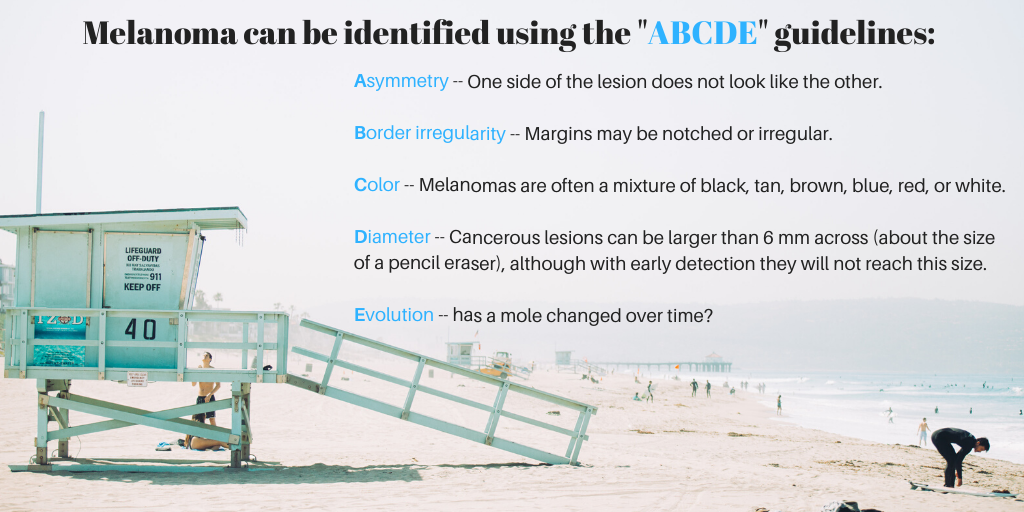
This year many of us were confined to staying home because of the coronavirus pandemic, and although life may be in pause, your health isn’t. Now with summer upon us, many of us are looking forward to getting outside and enjoying the warm weather. While we are doing this, it is important to keep in mind that we must protect ourselves against the harmful rays of the sun as we go about enjoying outdoor activities.
Skin cancer is the most common cancer in the United States and worldwide. One in five Americans will develop skin cancer by the age of 70 and it is estimated that 6,850 deaths will occur from the most aggressive version of skin cancer, melanoma. Melanoma is the most dangerous kind of skin cancer because it typically will spread to other areas of the body, including your organs, if it’s left untreated.
Here are some tips to stay safe while being out in the sun:
How can I know if I have melanoma?
The ABCDE’s of Melanoma and its warning signs are an easy way to help guide us to identify suspect skin spots that may need biopsy. These five features are useful, but do not replace a good skin evaluation by a dermatologist:
- A is for Asymmetry. Most melanomas are asymmetrical. Meaning one of the half of the skin lesion doesn’t match the other. It looks different from a round, oval or symmetrical common mole.
- B is for Border. Look for uneven, scalloped or notched edges. Common moles tend to have smoother, more even borders.
- C is for Color. Melanoma can have different shades of brown, black or tan. As it grows, the colors red, white or blue may also appear. Benign moles are usually a single shade of brown and may be quite uniform in color.
- D is for Diameter. Cancerous lesions can be larger than 6 mm in diameter, similar to the size of a pencil eraser, however with early detection they will not reach this size.
- E is for Evolving. Any changes in size, shape, color or elevation over time. Remember that the sun can make your skin and the moles darker in color. Moles often change their appearance as a result of pregnancy. Also be on the lookout for evolving new symptoms from the skin, such as bleeding, itching or crusting.
About melanoma
Melanoma is a serious form of skin cancer that can be deadly. The diagnosis is made by a skin biopsy and not by exam alone. The decision to biopsy a skin lesion is typically made after an assessment by a dermatologist.
Dermoscopy and confocal microscopy are two tools that dermatologists can use to evaluate skin lesions to help determine the need for biopsy. These techniques are non-invasive and help to highlight features in the skin that are common in cancer.
Patient resources
A number of mobile phone apps have been created for patients to use to assess their moles employing the camera on their phone, either through software analyses in the app, or by transmitting the images to be evaluated elsewhere. While these apps continue to improve, they have yet to replace a thorough skin exam from a dermatologist. The diagnosis of melanoma is made by skin biopsy and evaluation of the tissue by a pathologist. When melanoma is diagnosed in most cases, patients are treated surgically and most are cured.
The surgical treatment for melanoma has evolved over the last twenty years and are relative standard throughout the world.
The Saint John’s Cancer Institute Melanoma Program pioneered a number of less radical procedures for melanoma treatment. This means patients are able to be treated without the pain and other side effects of traditionally more aggressive approaches.
When in doubt, schedule an appointment with a specialist
Identifying a potential skin cancer is not easy, and not all melanomas follow the rules of the ABCDEs. Melanomas come in many forms and may display none of the typical warning signs. It’s also important to note that about 20 to 30% of melanomas develop in existing moles, while 70 to 80% arise on seemingly normal skin. Watch for new moles or freckles that arise on your skin, a sore that does not heal, or a change in any existing moles or spots.
If you’ve had melanoma in the past, also be sure to follow up regularly with your doctor once treatment is complete and stick to the schedule your doctor recommends. It is important to detect recurrences or new melanomas early in their course.
Melanoma doctors and specialists
Meet our team of Melanoma experts. Located in Santa Monica, California, we are here for you. Watch our video to learn how our team provides personalized, patient centered care to meet your unique needs.

